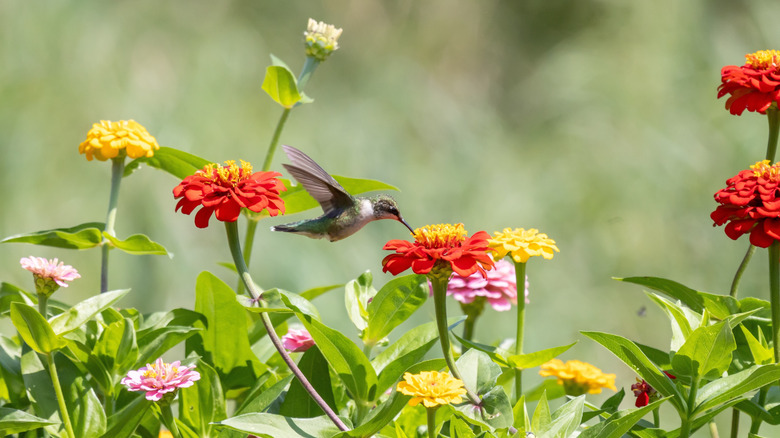Your Yard Will Be A Hummingbird Magnet After Planting This Stunning Flower
A single hummingbird can visit over a thousand flowers in one day. With metabolisms that run faster than almost any other bird, hummingbirds need a steady supply of nectar just to stay airborne. And while making your own hummingbird feeders can help, the real secret to keeping these fast-moving visitors around is building a garden that works on their terms.
Hummingbirds go for bright, tubular flowers with no scent, especially those in red and orange tones. Those colors grab their attention more than any others, and the shape gives them easy access while hovering. Unlike most birds, hummingbirds don't flap their wings. They move them in a figure-eight pattern that lets them stay suspended mid-air, which is a unique advantage when feeding from tall stems or hard-to-reach flowers people plant for hummingbirds. One plant that checks nearly all of these boxes, but often goes overlooked, is lion's ear (Leonotis leonurus). It grows in dry, open areas of southern Africa and handles similar conditions in home gardens without trouble, thriving in USDA Hardiness Zones 8 through 11.
In late summer, it puts out tall stems with bright orange, tube-shaped flowers that bloom when many other nectar plants fade. Since hummingbirds hover to feed, they don't need a place to land. Lion's ear has flowers right along the stem, making it easy for them to reach the nectar. In warm climates, the plant produces blooms through winter and into early spring, when most nectar sources have already called it quits. However, it's important to note that lion's ear is invasive in Florida and Hawaii. Avoid planting this flower if you live in either of those states.
Common mistakes to avoid when planting lion's ear
Lion's ear may be low-maintenance, but several common mistakes can keep it from blooming ... and from drawing in the hummingbirds you planted it for in the first place. The biggest issue is overwatering. This plant isn't fussy otherwise. It grows well in most garden soils as long as the area drains properly and doesn't stay wet for too long. For the best results, give it a spot that gets plenty of sunlight during the day, though it can manage in areas with some light shade. It also doesn't struggle much with pests or diseases, which makes it even easier to care for. The only time you might run into issues is when keeping the plant indoors over the winter — then, watch out for spider mites and whiteflies.
Trimming lion's ear helps it grow in a fuller shape, and it benefits from being cut back once a year when flowering has finished. If you prune it too early or remove too much at once, it can affect how well the plant blooms the following season. In colder regions, the top part of the plant may die off in winter. But like many hardy flowering plants, lion's ear often returns in spring by sprouting fresh growth from the base.
Mulching the crown can improve its chances of surviving frost, and container-grown plants can be overwintered indoors for extended blooming. Skipping these basics can leave you with a tall, leafy plant and few — if any — hummingbird visits. But with the right care, lion's ear will deliver bright blooms and steady pollinator traffic well into the colder months.

